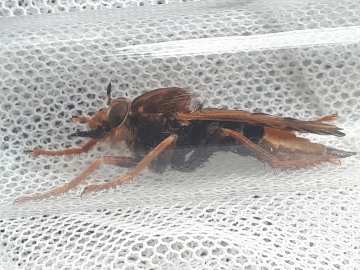Species Account for Asilus crabroniformis
Asilus crabroniformis Linnaeus, 1758
Diptera: Larger Brachycera: Asilidae

Reproduction for study and non-profit use permitted, all other rights reserved.
Taxonomic group: soldier flies and allies (Diptera: Larger Brachycera) - County data
View time series maps for Asilus crabroniformis
member log-on for taxon report
Status: Section 41 Priority Species
Essex BAP: Listed
Essex RDB: Listed
Threat: Essex Threatened
Images
upload a new image
Species text
The Hornet Robber Fly Asilus crabroniformis is a priority UKBAP species on the basis of its decline, with post-1970 records from only about 40 ten km squares nationally (UKBAP). Smith (2000) suggests that there are no more than 40-45 sites in England where populations of Asilus are breeding. The fly is found in unimproved grassland and heath in southern England and Wales. However, these habitats have shown significant decline in range and quality in recent years, with fragmentation enhancing the difficulties facing this insect. The fly's larvae are believed to prey on the larvae of large dung beetles and the adult flies feed on a variety of insects, including grasshoppers, dung beetles and flies. As such, it requires suitable grassland sward to support its prey community. Current factors causing loss or decline nationally are the loss of unimproved grassland and heath leading to habitat fragmentation, the use of persistent parasite treatments for stock (e.g. ivermectins) which kill dung beetle hosts and changes in stock management. Dung used for oviposition so far appears to only be cattle and rabbit (Pinchen et al. 1998). However an association with horses at sites in the UK, including Broom Hill and the Dagenham Corridor in Essex needs further investigation. Putative hosts and/or prey for larval Asilus in the UK are assumed to be some of the larger species of dung beetle such as Geotrupes or possibly Typhaeus (Smith, 2000). The co-occurrence with Minotaur beetles Typhaeus is strong on heathland sites (Pinchen et al. 1998). Asilus crabroniformis is an Essex Red Data species that should be considered Vulnerable or even Endangered in the county. It is subject to an Essex BAP Species Action Plan. In Essex it has been recorded in recent years only from a handful of sites in the south of the county, in remnant species-rich grassland on Thames Terrace sands and gravels and grazing marshes between Tilbury and East Tilbury, and in the Dagenham Corridor. These sites have a history of cattle and/or horse grazing, but at some rabbits are also present. None of the sites benefits from statutory protection. Indeed despite the presence of both the UKBAP species and many other rare and scarce species, two key sites near Tilbury have been lost, one to development and the second to capping and so called restoration. One of the two known sites in the Dagenham Corridor has also probably now been destroyed by landscape 'restoration' (Harvey, 2003b). References
Habitats
Recorded management for locations with Asilus crabroniformis
Recorded substrate and hydrology for locations with Asilus crabroniformis
Why not join the Club, register and add a new species page
Interpretation of distribution maps




















